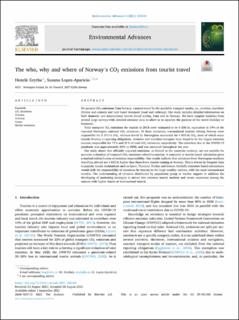| dc.contributor.author | Grythe, Henrik | |
| dc.contributor.author | Lopez-Aparicio, Susana | |
| dc.date.accessioned | 2021-09-10T10:34:00Z | |
| dc.date.available | 2021-09-10T10:34:00Z | |
| dc.date.created | 2021-09-07T11:00:27Z | |
| dc.date.issued | 2021 | |
| dc.identifier.citation | Environmental Advances. 2021, 5, 100104. | en_US |
| dc.identifier.issn | 2666-7657 | |
| dc.identifier.uri | https://hdl.handle.net/11250/2775198 | |
| dc.description.abstract | We present emissions from Norway’s tourist travel by the available transport modes, i.e., aviation, maritime (ferries and cruises) and land-based transport (road and railways). Our study includes detailed information on both domestic and international tourist travel within, from and to Norway. We have coupled statistics from several large surveys with detailed emission data to allow us to separate the purpose of the travel (holiday or business). Total transport emissions for tourists in 2018 were estimated to be 8 530 kt, equivalent to 19% of the reported Norwegian national emissions. Of these emissions, international tourists visiting Norway were responsible for 3 273 kt , whereas travel by Norwegians accounted for 4 875 kt , most of which occur outside Norway’s reporting obligations. Aviation and maritime transport were found to be the largest emission sources, responsible for 71% and 21% of total emissions, respectively. The reduction due to the COVID-19 pandemic was approximately 60% in 2020, and was sustained throughout the year. Our study shows that officially reported emissions, as limited to the countries territory, are not suitable for accurate evaluation of transport emissions related to tourism. A consumer or tourist-based calculation gives a marked redistribution of emission responsibility. Our results indicate that emissions from Norwegian residents travelling abroad are 1 602 kt higher than those from tourists coming to Norway. This is driven by frequent trips to popular tourist destinations such as Spain, Thailand, Turkey and Greece. Globally consumer based calculations would shift the responsibility of emissions by tourists to the large wealthy nations, with the most international tourists. The understanding of emission distributed by population group or market support in addition the developing of marketing strategies to attract low emission tourist markets and create awareness among the nations with higher shares of international tourist. | en_US |
| dc.language.iso | eng | en_US |
| dc.rights | Navngivelse-Ikkekommersiell 4.0 Internasjonal | * |
| dc.rights.uri | http://creativecommons.org/licenses/by-nc/4.0/deed.no | * |
| dc.title | The who, why and where of Norway’s emissions from tourist travel | en_US |
| dc.type | Journal article | en_US |
| dc.description.version | publishedVersion | en_US |
| dc.rights.holder | © 2021 The Authors. Published by Elsevier Ltd. | en_US |
| dc.source.volume | 5 | en_US |
| dc.source.journal | Environmental Advances | en_US |
| dc.identifier.doi | 10.1016/j.envadv.2021.100104 | |
| dc.identifier.cristin | 1931908 | |
| dc.relation.project | NILU - Norsk institutt for luftforskning: 119141 | en_US |
| dc.relation.project | NILU - Norsk institutt for luftforskning: 120011 | en_US |
| dc.source.articlenumber | 100104 | en_US |
| cristin.ispublished | true | |
| cristin.fulltext | original | |

